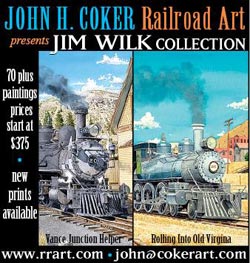

Seattle & Walla Walla Railroad and Navigation Co.
By Heather M. MacIntosh, September 23, 1999HistoryLink.org Essay 1686
T he Seattle & Walla Walla was Seattle's first railroad. Seattleites built it in reaction to Northern Pacific's 1873 decision to locate its western terminus in Tacoma rather than in Seattle. The Seattle & Walla Walla began at Steele's Landing on the Duwamish River, and eventually extended for 21 miles to the coal mines of Newcastle, in South King County, Washington. In 1880, it was purchased by Henry Villard's Oregon Improvement Company and renamed the Columbia and Puget Sound Railroad. Its short history reflected Seattle's early hopes to be a commercial center on the Puget Sound, as well as the chimerical character of the quickly changing railroad industry in the last decades of the nineteenth century.
High Hopes Dashed
The seeds of the Seattle & Walla Walla Railroad were sown by a terse Northern Pacific telegraph sent to Arthur Denny (1822-1899) on July 14, 1873 which read, "We have located the terminus on Commencement Bay." This devastating announcement that Tacoma and not Seattle would serve as the Northern Pacific's terminus came after years of excited speculation. The railroads were definitely coming to the Northwest: In 1864 the Northern Pacific received a charter to build a line from Lake Superior in the Midwest to some point on the Puget Sound. This raised the hopes of many burgeoning communities on the Sound. In 1870, in Washington Territory (the state was ratified in 1889), work began in Kalama on the Columbia River. Seattle huffed an exasperated sigh when the railroad opted against building through Snoqualmie Pass -- a route through the Cascade mountains that would have made Seattle a natural terminus.
Although Tacoma's population numbered only a few hundred in the early 1870s, the railroad chose the port on Commencement Bay over its northern neighbor Seattle in 1873. This decision fanned Tacoma's hopes, and Seattle's ire.
Undaunted, Seattle's population reached into its wallets, and into the coffers of some East Coast investors, rolled up its sleeves, and tapped what became know as the "Seattle Spirit." Much of the town turned out on May 1, 1874, to begin laying the Seattle & Walla Walla Railroad's first tracks at Steele's Landing on the mouth of the Duwamish River. Almost all able-bodied men volunteered toward this Herculean, and highly civic-minded effort.
A Long Haul
The importance of a direct rail link into Washington's fertile agricultural heartland on the eastern side of the Cascade Range was not imagined -- the products of the rich farmland of Eastern Washington could be delivered more quickly and cheaply via the proposed passage than on the Northern Pacific's circuitous route. This fact underlay the practical arguments for a line between Seattle and Walla Walla.
But funding such a project proved difficult. Many of Seattle's founders came together as trustees of the Seattle & Walla Walla Railroad and Transportation Company: Arthur Denny, Henry Yesler (1810-1892), John J. McGilvra (1827-1903), Dexter Horton (1825-1904), and James M. Colman (1832-1906) all served on the company's board. Despite enthusiastic support from Walla Walla, the territorial legislature did little to lighten the financial burden of building a railroad. Undaunted, Seattleites volunteered their own labor to grade and lay the railroad's tracks, in order to eliminate most of the estimated 3 to 4 million dollar price tag.
On May 1, 1874, the day Seattle first broke dirt on Steele's Landing, spirits were high. Women prepared a tremendous noontime meal for the men, buoying the moral of an already invigorated volunteer workforce. Each man, it was hoped, would volunteer one day a week to the effort until the rail line topped and descended the Cascade Mountains.
Notwithstanding the high enthusiasm, the goal, 15 miles of operating track by winter, was not met. By October, 1874, volunteers had graded 12 miles.
Mining Opportunities
The line was slowly pushed south five miles to the new coal mines in Renton. James M. Colman (of Colman Dock fame) then took charge and hired Chin Gee Hee and his crew of immigrant Chinese workers to extend the line to Newcastle. Although the Seattle & Walla Walla never got close to the city in its last name, the final 21-mile line earned quick profits hauling coal from the South King County mines to Elliott Bay piers and helped to establish Seattle as the economic center of Puget Sound. The company hoped to entice Eastern investors with the profitability of the small line, but without success. The line itself, which transported coal from the Renton and Newcastle mines to the Seattle docks, was nonetheless highly profitable.
Henry Villard (1835-1900), whose Oregon and Eastern Washington railroads and steamship lines were filling the void left by the Northern Pacific's paralysis, was quick to note Seattle's successes. He bought the Seattle & Walla Walla (and its generous waterfront franchise) in 1880, reorganized it as the Columbia & Puget Sound Railroad, and erected the town's first train depot, little more than a shed, not far from where Union Station would rise 20 years later. Villard allegedly paid $250,000 for the railroad. The coal mines, land holdings, and ships carrying coal to California port brought another $750,000.
The story of the Seattle & Walla Walla was but the first chapter in Seattle's ongoing struggle for a transcontinental connection. This goal -- a direct connection from the Pacific Northwest to the East Coast and to many points along the way -- would take another decade to materialize.
Bibliography
Clarance Bagley, The History of Seattle, Vol. I, (Chicago: S. J. Clarke Publishing Company, 1916);
Carlos Schwantes, Railroad Signatures Across the Pacific Northwest, (Seattle: University of Washington Press, 1993).
Reference Material Available Online:
Photographs.
Collected Seattle & Walla Walla Railroad and Navigation Co. Photographs.
Images collected from private collections, libraries and historical societies.
Newspaper Clippings.
Collected Period News Articles.
Washington \ Seattle and Walla Walla Railroad and Navigation Co.


